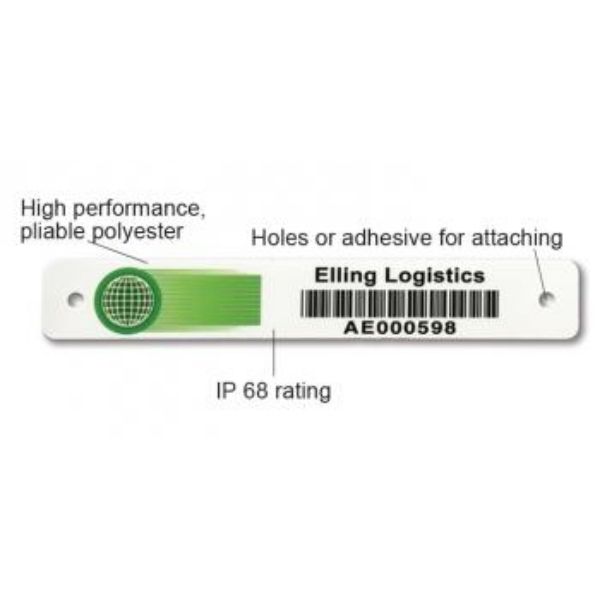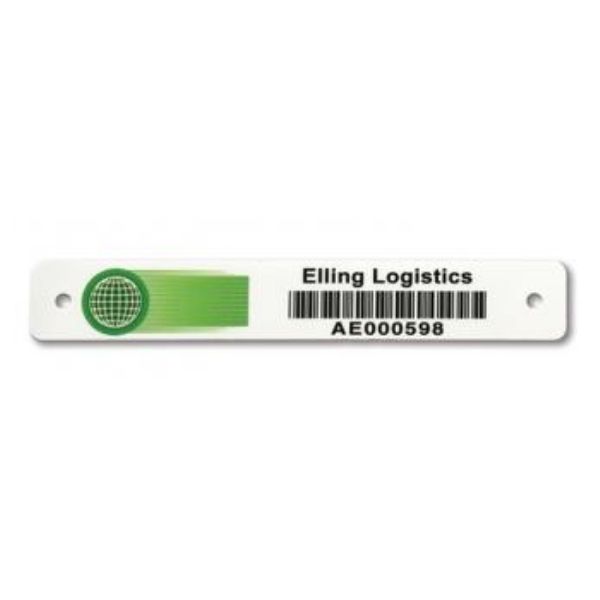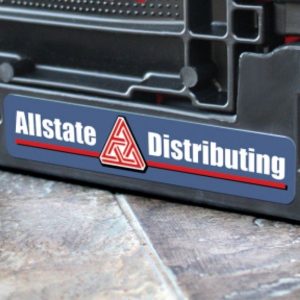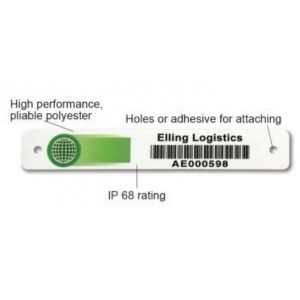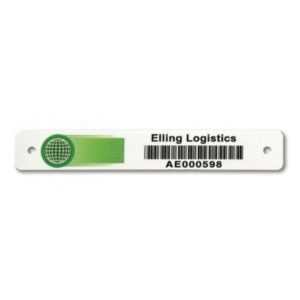Project Description
The Flex Hard Tag has been specifically designed for assets that need a rugged, yet flexible, polymer RFID tag that is more cost effective than traditional hard tags and has reliable, consistent read range performance.
Reusable containers, pallets, and other mobile assets are exposed to a wide variety of environment and working conditions. Abrasion, UV exposure, dirt, and moisture can affect the durability and longevity of your RFID tags. The Flex Hard Tag is made of high-performance, pliable polyester that provides more strength and rigidity than a traditional RFID polyester label but is more formable than a metal or hard plastic tag.
The Flex Hard Tag is ideal for returnable pallets, plastic crates, containers, utility poles or for embedding in injected molded products. Along with a RFID read range of 6.0 to 7.5m on most applications, the Flex Hard Tag is versatile and durable enough for almost any returnable container or harsh environment RFID tracking project.
Semi-rigid polyester construction offers increased durability and strength over other RFID tags
Optional subsurface printing protects against extreme solvents, caustics, acids, and abrasion.
Ideal for high wear applications including returnable pallets, containers, utilities and embedding within injected molded products
IP68 Ingress Protection
Average read range 6.0 to 7.5m
| Material | .002” or .003” polyester for subsurface printing, .007” polyester inlay covering, .007” polyester base. Approximate .020” total product thickness. |
| Serialization | Barcode and human-readable equivalent is produced using the latest high-resolution digital technology available, which provides excellent clarity and easy scanning. Code 39 is the standard symbology with a range of 2.7 to 9.4 CPI. |
| Label Copy | The label copy may include block type, stylized type, logos or other designs. All copy, block type, stylized type, logos, designs, and bar code are subsurface printed. This unique process provides excellent resistance to environmental factors. |
| Colors | Standard colors include black, red, yellow, green or blue. Custom spot colors are also available at no additional charge. Due to contrast needed for the bar code scanner, all bar codes are black. |
| Standard Adhesive | High performance adhesive |
| Frequency Range | 860-960 MHz |
| Sizes | Various sizes available:- 67mm x 57mm | 105mm x 19mm | 114mm x 19mm |
| Packaging | Shipped in “work-out- of” cartons for convenient application. |
| Shipment | 14 business days |
Asset Tracking
Inventory Management
OEM Product Identification
Plastic Totes
-
Chemical Testing
-
Temperature Testing
-
Destructive Testing
-
Abrasion Testing
-
Injection Molding Process and Testing
Chemical Test Summary
Test of label structure and printed image as well as readability of inlay.
Chemical Test Data
| Immersion Time | 2 Hrs | 24 Hrs | 48 Hrs |
| DI Water | no effect | no effect | no effect |
| Salt Water | no effect | no effect | no effect |
| Bathroom Cleaner | no effect | no effect | no effect |
| Glass Cleaner | no effect | no effect | no effect |
| Isopropanol | no effect | Adhesive Ooze Around Perimeter of Tag | Adhesive Ooze Around Perimeter of Tag |
| Brake Fluid | no effect | no effect | no effect |
| Acetone | Adhesive Ooze Around Perimeter of Tag | Adhesive Ooze Around Perimeter of Tag/Tag Delaminated | Adhesive Ooze Around Perimeter of Tag/Tag Delaminated/Inlay no read |
| Diesel Fuel | no effect | Adhesive Ooze Around Perimeter of Tag | Adhesive Ooze Around Perimeter of Tag |
| Nitric Acid | no effect | no effect | no effect |
| Hydrochloric acid | no effect | no effect | no effect |
| Sodium Hydroxide | no effect | no effect | no effect |
| Skydrol | no effect | Adhesive Ooze Around Perimeter of Tag | Adhesive Ooze Around Perimeter of Tag |
High-Temperature Test: All samples were applied to glass test panels and subject to 10 minutes of cumulative exposure to 65°C, 93°C, 121°C, and 150°C. The results were taken immediately after removal from the oven. No adhesion loss to substrate, warping, or delamination was observed, and all inlays read post-exposure.
Low-Temperature Test: All samples were applied to polypropylene and subject to -1.3°F for 24 hours. The results were taken immediately after removal from the freezer. No adhesion loss to the polypropylene was observed, and all inlays read correctly.
Pressure Washer Test: Labels were applied to a polypropylene test panel and allowed to wet out for 24 hrs. High-pressure washing consisting of spraying room temperature water for 30 seconds.
Spray was directed at the edges of the label to force delamination. No delamination occurred, no other defects were observed and the inlay read after exposure.
Test Summary
Samples were tested on the Taber 5130 abrader with CS-10 wheels with a wheel load of 500g each (1000g total).
All samples survived 20,000 revolutions.
Test Summary
Injection Mold Specs: ABS resin temperature: 249°C, Injection pressure: 500-800 PSI, Total mold cycle time: 26 sec.
All tested tags were readable after being molded into the component.


